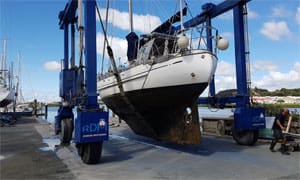Editor’s note: There are many types of hull design, rig configuration and material choices for offshore sailboats. We talked to four voyaging couples and asked them about the pros and cons of the choice they made when they decided on a voyaging boat.
Rich and Cat Ian-Frese
Tayana 37 Anna
Rich and Cat Ian-Frese left Seattle after an 11-year refit of their Tayana 37 cutter, Anna. They started out heading in the general direction of South America, where they eventually took a right turn and crossed the South Pacific. They have refit, cruised and lived aboard Anna since 2000.
Rich has a background in research engineering and spent many years working on research grants in emerging laser technologies. He has worked as a project director on R&D projects for the U.S. Department of Energy, the National Science Foundation and NASA. Cat spent over 20 years teaching elementary school, including special education.
Ocean Navigator: Why did you decide to voyage in a heavy-displacement boat?
Rich and Cat Ian-Frese: My wife and I decided to voyage in a full-keel (with cutaway forefront) heavy-displacement monohull, a Tayana 37 cutter rig, because it has a comfortable and easy motion in the ocean. It feels solid and stable and safe in big waves, even in big confused waves — although the comfort factor is noticeably reduced in big confused waves, as it would be on any vessel in rough seas where the waves are big, short-spaced and coming from multiple directions. This will cause bashing into a headwind and heavy, lumpy rolling dead downwind. In our opinion, a heavier displacement vessel will absorb getting knocked around better than a light-displacement monohull.
ON: What are the advantages and disadvantages of this type of offshore boat?
R&CI-F: The advantages of a heavy-displacement monohull, like the Tayana 37 cutter, are a very stable and comfortable ride in normal ocean conditions. The Tayana 37 has modest initial stability for a moderately heavy displacement boat, and it will comfortably heel over initially to dig in and pick up speed and add to its waterline length. And then its secondary stability kicks in, which is effective in keeping you sailing at a comfortable heeling angle. We’ve never felt the heeling angle to be unsafe, even in big rolling seas.
 |
|
Rich and Cat Ian-Frese prefer the stability of a heavy-displacement boat like Anna, and are willing to trade speed for comfort. |
|
Rich Ian-Frese |
We don’t feel that there is any significant disadvantage to a heavy-displacement boat that is used for ocean voyaging, unless speed is your priority. We’ve never been in a situation where not being able to outrun bad weather resulted in a bad outcome. We think that it would be advantageous at times to attain a knot of speed for every knot of wind, like some fast monohulls and catamarans we know of, but we’re happy to slip along at 4 to 7 knots. It seems less stressful on the boat and rig, and less stressful on the crew as well, especially when conditions deteriorate. Besides, we like being on the ocean and don’t place a lot of emphasis on getting from point A to point B in record-setting time. But that’s just us; we can certainly see how hull speeds of 10 to 20 knots can be appealing when you actually have a chance to get ahead of a forecast bad weather system or have simply just had enough rolling on a 3,000-mile passage.
Many heavy-displacement vessels are full keeled. And while a full-keeled monohull like the Tayana 37 has advantages on the ocean — like righting itself quickly if rolled in heavy seas, and having an easy motion in normal seas, an excellent balance of primary and secondary stability, and a modest turn of speed — there is perhaps a disadvantage in close-quarters work.
In marinas where getting into a Travelift dock or a fuel dock involves backing up in a straight line in windy conditions or in a strong current, maneuverability can be a challenge. We could never back up our Tayana 37 down a narrow fairway and expect to end up exactly where we want to go. It’s not in the nature of the Tayana 37. Bow thrusters are, of course, an option, but we didn’t have thrusters on our boat. Many other boats with long keels, other than the Tayana 37, are simply bad when the transmission is thrown into reverse. Occasionally, we are lucky and the wind and current help us along. But generally the less distance we need to go in reverse, the better. Normal docking and turning in narrow fairways is fine. Just don’t expect consistently perfect results in reverse gear in a heavier breeze or fast-running current with some full-keel boats.
We had a Pearson 30 a long time ago. It had a light displacement and a spade rudder. It could turn on a dime and back down a long narrow fairway in almost any conditions. But there are tradeoffs with any boat. We would never think of taking that vessel on a long ocean voyage with its unprotected rudder. When most of your time is spent on longer passages in unpredictable conditions, a good stable boat that you have complete confidence in when the weather goes south is most important.
ON: For voyagers considering a heavy-displacement sailboat, what advice would you give?
R&CI-F: We wouldn’t hesitate to sail a heavy-displacement boat. Personally, we’d feel more secure in conditions that were other than ideal. A heavy-displacement monohull doesn’t guarantee comfort in heavy weather, but it will buffer the ride and offer a degree of stability and security that you may feel is lacking in a light-displacement boat. If you want speed and comfort running downwind in the South Pacific, then a catamaran might be right for you. There are light-displacement catamarans and also moderately heavy displacement oceangoing catamarans about 48 to 50 feet in length that could take you just about anywhere that a shorter, stout, heavy-displacement monohull could. We choose the Tayana 37 cutter for its ruggedness in the ocean. It’s comfortable for a short-handed crew to operate, it’s economical at 37 feet and it has never let us down when in heavier ocean conditions over the past 20 years. It’s utilitarian. You might call it the Jeep of sailboats.
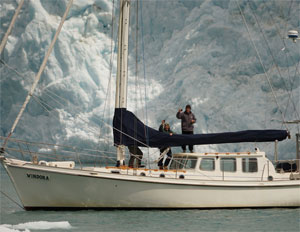 |
|
Voyagers Lynda and Phil Christieson celebrate aboard their wooden ketch Windora in Patagonia. |
|
Phil and Lynda Christieson |
Phil and Lynda Christieson
Kauri ketch Windora
Phil and Lynda Christieson from New Zealand have owned and cruised extensively on Windora, a 43-foot Kauri ketch, for the last 26 years. They circumnavigated with their two sons in the ‘90s and are now completing a six-year cruise in the higher latitudes.
Ocean Navigator: Why did you decide to voyage in a wooden-hulled boat?
Phil and Lynda Christieson: When we went looking for a cruising yacht, we were extremely lucky to find Windora, a proven offshore vessel, within our budget. Coming from New Zealand, where wooden boats are built from far superior materials, there was never any question that a wooden boat was inferior, and we learned very quickly that we had an exceptional boat. Being of wood construction, the interior is a piece of artwork, leaving you in no doubt that you are on a real boat, not a floating caravan.
ON: What are the advantages and disadvantages of this type of offshore boat?
P&LC: Windora is a composite wooden boat, strip-planked with a heavy layer of epoxy glass fiber. This creates a high-strength, totally dry hull. It provides the most comfortable environment to live in, both in tropical and high-latitude climates. Repairs and maintenance can be done in the most remote places with easily available materials. There are large areas of the planet where you are treated differently because you sail a wooden boat. You are not just another white plastic boat; you stand out in the crowd. A traditionally planked wooden boat cannot be left on the hardstand for extended periods.
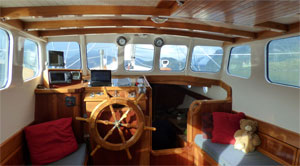 |
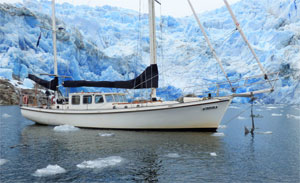 |
|
|
This interior shot of Windora shows the beauty of wooden boat construction. |
Windora has two layers of fiberglass protecting its wooden hull from damage like this ice in Chile can cause. |
|
|
Phil and Lynda Christieson |
ON: For voyagers considering a wooden-hulled sailboat, what advice would you give?
P&LC: First choice would be wood-composite construction, which lets you use two-part urethane paint systems, allows for minimum maintenance, and gives you the advantage of being able to store the boat ashore in the most extreme climates. You need to ensure the surveyor has a good understanding of wooden boats, as they are the most complex in construction of all the materials. A poorly built wooden boat can be hugely expensive to put right. Never touch any wooden vessel with iron fastenings in it.
Dave and Sherry McCampbell
St. Francis 44 catamaran Soggy Paws
Dave and Sherry McCampbell left Florida in May 2007 and headed west across the Pacific via the Panama Canal. They spent eight years getting across in their 1980 CSY 44 monohull. By 2015, they were ready for a faster boat and switched to a 2005 St. Francis 44 MK II catamaran. After four years exploring much of eastern Southeast Asia and a number of significant modifications, they now have the perfect cruising home.
Ocean Navigator: Why did you decide to voyage in a multihull?
Dave and Sherry McCampbell: We are full-time international cruisers. There were many reasons we switched from our 1980 CSY 44 monohull to our 2005 St. Francis 44 catamaran. But the bottom line is that it was better suited to our increasing age and desire for more safety, more comfort and less maintenance. Below are the most important reasons to us that we switched. These mirror some of the most important advantages and disadvantages of a catamaran versus a monohull.
ON: What are the advantages and disadvantages of this type of offshore boat?
D&SM: Here are what we see as the main advantages.
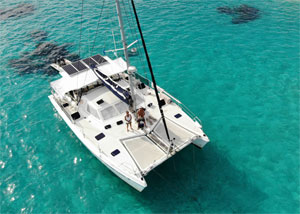 |
|
Dave and Sherry McCampbell’s St. Francis 44 catamaran Soggy Paws at anchor at Tetepare in the Solomon Islands. |
|
Dave and Sherry McCampbell |
Level sailing: Cats sail relatively flat, so there is far less fatigue on a passage. Because of this, we can finally read and do computer work most of the time underway. That was rarely possible on the CSY monohull while rolling along at a 10- to 15-degree heel. This is really important for full-time cruisers and not well understood by the monohull cruising community. See the Navy study from a few years ago on page 24 of my presentation link below.
Layout: There is typically about 40 percent more room on a modern cat than on a monohull of similar length. A cat layout is much more cruising-friendly, with daily living, navigation and watch-standing areas up, and bunks, storage, heads and mechanical spaces down. The main saloon and cockpit are on the same level, so there’s no need for a ladder transit between them. It is also easier to access multiple storage lockers along the sides of two hulls instead of one, or searching for things under bunks and in the bilges.
Two engines: Modern cats generally have better speed and fuel economy while motoring. Motoring at 5 knots with one small engine properly loads up the engine and uses roughly half the diesel we used to use with the CSY. That means we can carry roughly half the fuel we used to carry for a 1,200-nm range. Two engines also means a full spare parts inventory is always on board, and there is no drama if one should develop a problem needing repair at sea.
Maintenance: The newer boat and more room mean generally easier maintenance for electrical and mechanical equipment. No teak on deck means no varnish work ever! A more modern rig makes rigging work and sail handling easier.
Unsinkability: Many modern cats won’t sink regardless of damage, due to a thick foam-cored hull, waterproof crash compartments and lack of lead keel. Our cat has a 1.25-inch foam-cored hull and deck, and is advertised as non-sinking unless really overloaded. That is a really comforting feeling while underway in deep water hundreds of miles from land. We think staying aboard is a better option than having to abandon ship into a life raft.
Stability: Cats have better stability at anchor, in a seaway or riding to a sea anchor. Little rolling means better sleep at night. It also means most things left on counters and tables will stay put underway in reasonable conditions. Availability of strong, wide bridle attachment points at the ends of the forward crossbeam reduce yawing and therefore ground tackle loads.
Speed: Most comparisons I have read indicate about a 20 percent speed increase on long passages. We rarely want to go more than about 8 knots, and we start reefing at about 7 knots. This compares to reefing at 6 knots on the CSY. We are comfortable at 7 to 8 knots on the cat. In the open sea, we consider anything more than about 9 knots uncomfortable due to increased boat motion and rig loads.
Sail handling: Wide, flat decks with little roll mean safer sail handling and reefing at sea. The jib is relatively small compared to the main, so it is easier to handle than on most monohulls. Also, no pole is required for downwind sails or a spinnaker.
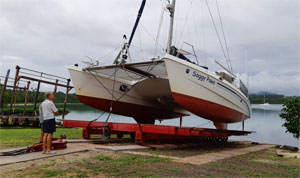 |
|
Soggy Paws hauled out in the Solomons. The multihull is equipped with stub keels. |
|
Dave and Sherry McCampbell |
Dinghy storage: Cats offer much safer and more convenient dinghy storage if lifted on high davits aft between the hulls. Typically, modern cats allow the dinghy (with motor on) to be taken out of the water easily and launched quickly. There is no need to remove the outboard and store the dinghy on the foredeck before making a passage.
Draft: The cat’s shallow draft gives many more anchoring options. This is especially important if looking for that mangrove-lined, unoccupied tropical cyclone hole. The ability to do a free haulout for repairs or a bottom paint touch-up on a beach is a huge advantage. It is easy to do on many beaches with just a few feet of tide.
Most of the monohull vs. catamaran comparisons, as well as catamaran features, are well covered in our PowerPoint presentation, “Evaluating Modern Catamarans,” available on our website.
ON: For voyagers considering a multihull, what advice would you give?
D&SM: There is no perfect catamaran with all the features you may want, so be prepared to compromise somewhat. However, knowing what works and what does not for the cruising you plan to do is important. Be sure to research this carefully before starting to look for a cat.
With the number of catamarans being produced on the rise, there are many designs to choose from. However, not all are created equal. Although most cruisers spend 90 percent of the time in port, due consideration should also be given to features that enhance safety and comfort at sea. Most catamarans are optimized for tropics cruising and are probably not the best choices for high-latitude voyaging.
There is plenty here to consider before purchasing a cruising catamaran. Much more is on the Internet. Many modern cats are built for the lucrative charter trade and may have features that don’t work well for full-time bluewater cruising. Some of these can be corrected or improved, some cannot. Be suspicious of exaggerated dealer claims, ask for proof of anything that doesn’t seem right, and ask specific questions. Consider making a list of what to look for before going shopping.
As with almost all cat owners I’ve talked to now that we have made the switch to the “enlightened side,” we would never go back.
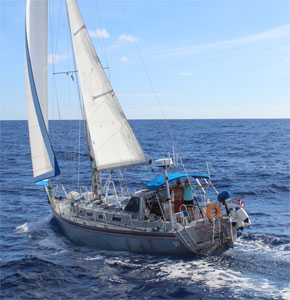 |
|
David Content and Roslyn Stewart’s Angelo Lavranos-designed, 43-foot aluminum sloop Barefoot underway off Fiji. |
|
Amanda Swan Neal |
David Content & Roslyn Stewart
Aluminum sloop Barefoot
David Content and Roslyn Stewart have been sailing their boat, Barefoot, in the Pacific for eight years. Roslyn has previously sailed in Papua New Guinea and northern Europe. David has sailed extensively in the North and South Pacific.
Ocean Navigator: Why did you decide to voyage in an aluminum boat?
David Content & Roslyn Stewart: My present voyaging sailboat is Barefoot, a 43-foot aluminum boat designed by Angelo Lavranos and built by Dearden Marine. I chose an aluminum boat after having already sailed more than 50,000 ocean miles in an excellent 36-foot, IOR-design fiberglass boat. Most influential in the decision was wanting a solid, strong boat that was still reasonably lightweight and would withstand the stresses and wetness experienced for weeks at a time on offshore passages.
I learned from cruisers sailing metal boats that they did not develop leaky chain plates, slack stays and shrouds, water intrusion in the rudder, loose keel bolts or squeaky interior liners at the bulkheads, even after thousands of ocean miles. For me, an aluminum boat was a better choice than steel because steel boats require a watertight paint coating on all metal surfaces. I wanted to avoid the paint maintenance, and I desired the lighter weight of an aluminum fabrication.
ON: What are the advantages and disadvantages of this type of offshore boat?
DC&RS: An aluminum boat is difficult to paint and doesn’t need it above the waterline. On Barefoot, the unpainted topsides are gray and protected by a naturally developing oxide coating. Some sailors perceive this as an advantage, while others prefer to paint the topsides for cosmetic purposes.
An obvious advantage of aluminum is that the robust cleats, chocks, handrails, stanchion sockets, chain plates, anchor rollers and genoa track bases are all permanently welded directly on the deck. In addition to being extremely strong, no potentially leaky deck penetrations exist. Inside the boat, aluminum frames and stringers serve as solid attachment bases for the interior handrails, autopilot ram, steering cable sheaves, and the generator and watermaker mounts.
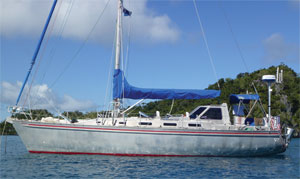 |
|
Barefoot has unpainted topsides, allowing the aluminum to develop a protective oxide coating. |
|
David Content |
Non-obvious advantages of an insulated aluminum boat are numerous. One example is that the insulated hull pulls the cabin and bilge temperature toward the water temperature rather than the air temperature. This means in the tropics we’re able to stow fruit and veggies in the cool bilge, and that no deck canopy is needed to keep the cabin cool, even in the tropical sun. Conversely, when sailing at high latitudes, the water temperature is warmer than the air and that keeps the boat naturally warmer.
Two disadvantages of aluminum boats are the cost of construction and the watchfulness required to avoid corrosion problems. Well-built aluminum boats are more expensive than production fiberglass sailboats. Aluminum fabrication costs are based on the material expense of proper aluminum alloys for hull plating, frames and stringers, and on labor costs for skilled aluminum welders. The construction process is more labor intensive than fiberglass boats.
Potential corrosion sources in aluminum boats are well understood by builders these days. Following best practices in electrical wiring and equipment isolation from the hull eliminates most corrosion risks. An aluminum boat owner can prevent corrosion by learning a few unique requirements. For example, an isolation transformer must be wired in the boat if connected to shore power; a charcoal filter must be used when filling an aluminum water tank from a city chlorinated water supply; never moor the aluminum boat next to a steel boat; never use chlorine cleaners for anything (use vinegar); and always have installed and regularly check an LED light indicating a fault from a connection between the hull and the positive or negative side of the battery.
ON: What is your advice for voyagers considering an aluminum vessel?
DC&RS: They should follow the same process as with the considered purchase of any boat: Talk to sailors who have a similar boat, inspect as many aluminum boats as possible, and consider having a custom boat built by selecting a good naval architect and finding a small, experienced aluminum boatyard for the build.

